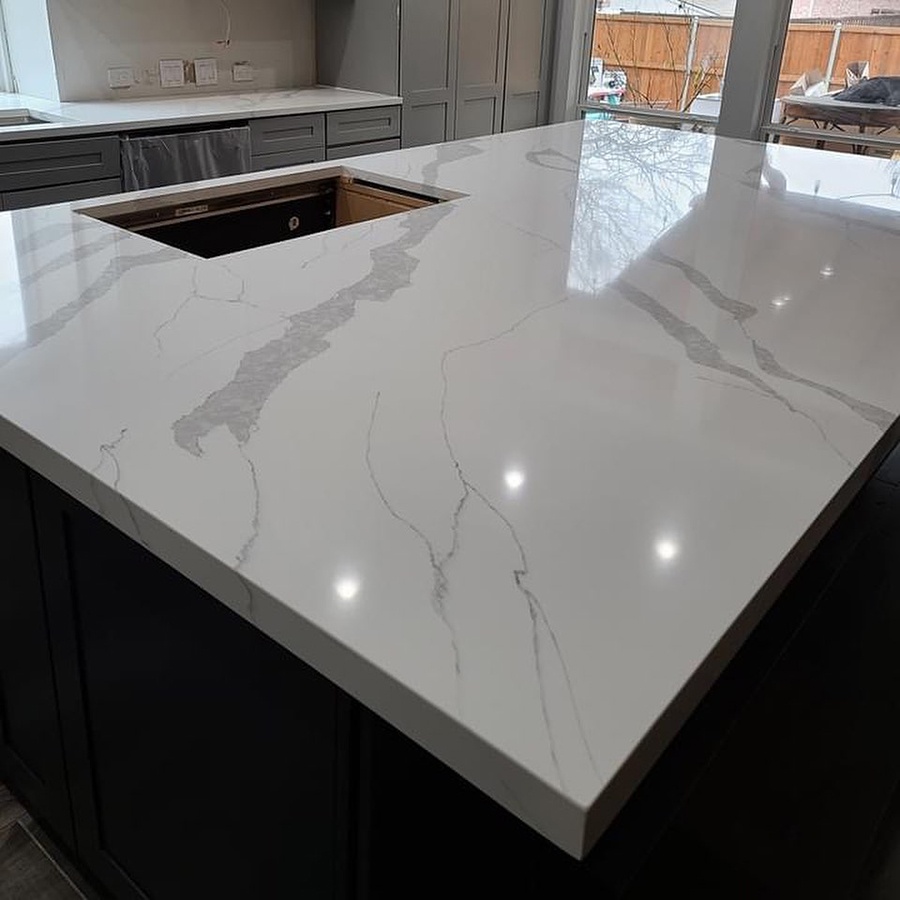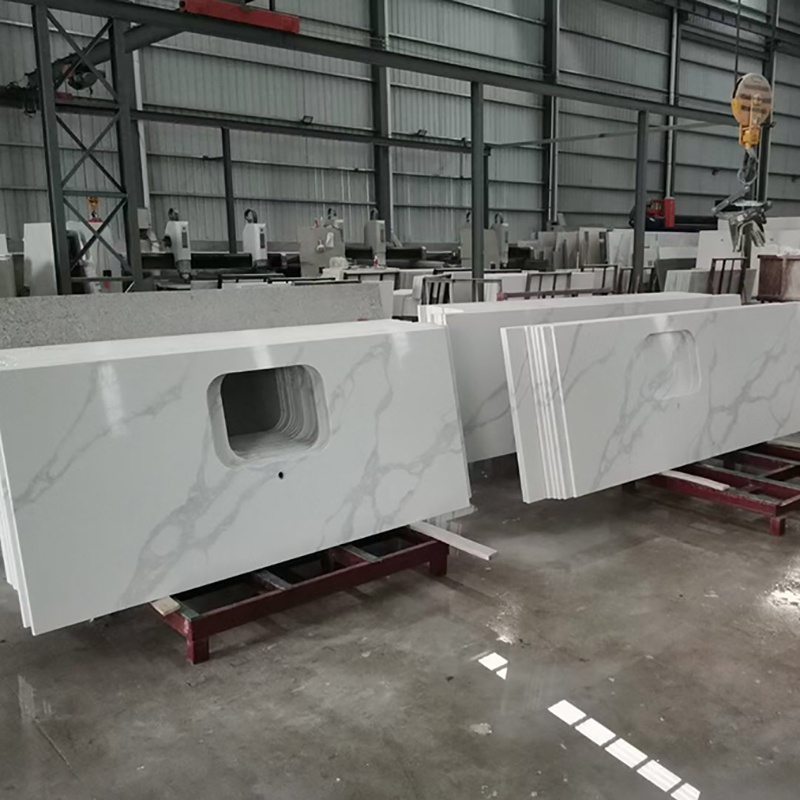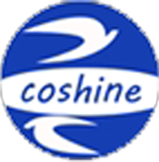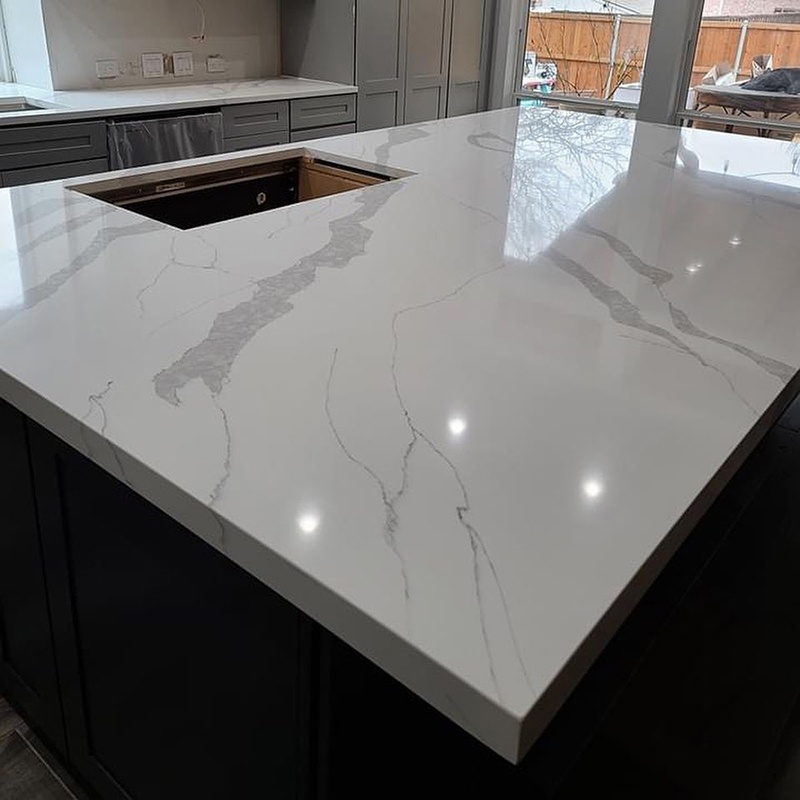Artificial stone usually refers to artificial stone solid surface material, artificial stone quartz stone, artificial stone granite and so on. Different types of artificial stone have different compositions. The main components are resin, aluminum powder, pigment and curing agent.
The practical building material using polymers, its manufacturing process is a chemical material reaction process, which is a practical scientific material that has been produced and continuously improved with the progress of human society, science and technology. Artificial stone is mainly used in the architectural decoration industry. It is a new type of environmentally friendly composite material. Compared with traditional building materials such as stainless steel and ceramics, artificial stone not only has multiple functions, rich colors, but also a wider range of applications. Artificial stone is non-toxic, radioactive, flame retardant, non-sticky, non-seepage, antibacterial, anti-mildew, wear-resistant, impact-resistant, easy to maintain, seamless splicing, and versatile in shape. The domestic artificial stone industry has just started, and most emerging companies are still in the stage of learning from industry leaders such as DuPont, Samsung and Du Lijia (China).
Classification
Resin type artificial stone
Resin-type artificial stone is made of unsaturated polyester resin as a binder, mixed with natural marble gravel, quartz sand, calcite, stone powder or other inorganic fillers in a certain proportion, and then added with catalysts, curing agents, pigments and other additives. It is processed by mixing and stirring, curing and molding, demolding and drying, surface polishing and other processes. Products using unsaturated polyester have good luster, bright and rich colors, strong processability, and good decorative effects; this resin has low viscosity, is easy to shape, and can be cured at room temperature. Molding methods include vibration molding, compression molding and extrusion molding. The artificial stone used in the interior decoration project is mainly resin type.
Composite artificial stone
Among the binders used in composite artificial stone, there are both inorganic materials and organic polymer materials. The production process is: firstly use cement, stone powder, etc. to make the body of cement mortar, and then immerse the body in organic monomers to polymerize under certain conditions. For the board, the bottom layer is made of stable and cheap inorganic materials, and the surface layer is made of polyester and marble powder. Inorganic cementing materials can be used for rapid hardening cement, ordinary portland cement, aluminate cement, fly ash cement, slag cement and plaster of paris. The organic monomers can be styrene, methyl methacrylate, vinyl acetate, acrylonitrile, butadiene, etc. These monomers can be used alone or in combination. The cost of composite artificial stone products is low, but its polyester surface is prone to peeling or cracking after being affected by temperature difference.


cement type artificial stone
Cement-type artificial stone is an artificial stone made of various cements as cementing materials, sand and natural gravel as coarse and fine aggregates, after preparation, mixing, pressure steaming, polishing and polishing. During the preparation process, coloring materials can be mixed to make colored cement stones. The production of cement-type stone materials is convenient and cheap, but its decoration is poor. Terrazzo and various flower-step bricks belong to this category.
Sintered artificial stone
The production method of sintered artificial stone is similar to that of ceramic technology. It is to mix feldspar, quartz, diabase, calcite and other powders with hematite powder and a certain amount of kaolin. The general ratio is 60% of stone powder. The clay is 40%, and the blank is prepared by the slurry mixing method, shaped by the semi-dry pressing method, and then fired in a kiln at a high temperature of about 1000°C. Sintered artificial stone has good decoration and stable performance, but it needs to be roasted at high temperature, so it consumes a lot of energy and costs high.
Because unsaturated polyester resin has the characteristics of low viscosity, easy to shape; good gloss; light color, easy to prepare various bright colors and patterns; fast curing, and can be operated at room temperature, it is the most widely used among the above stone materials. It is a resin-type artificial stone produced with unsaturated polyester resin as a binder. It has stable physical and chemical properties and a wide range of applications. It is also called polyester synthetic stone.
Identification method
Artificial stone is a synthetic decorative material. According to the different binders used, it can be divided into two types: organic artificial stone and inorganic artificial stone. According to the different production processes, it can be divided into four types: polyester artificial marble, composite artificial marble, silicate artificial marble, and sintered artificial marble.
Among the four artificial stone decoration materials, organic (polyester type) is the most commonly used, and its physical and chemical properties are also the best.
Marble is a high-grade decorative material, so you must be careful when purchasing it to avoid wasting money. The appearance quality of marble can be identified from the following items.
(1) Determine the color tone of the pattern. Under the condition of sufficient light, place the selected slabs and the same batch of other marble slabs to be purchased on the ground at the same time, and stand 1.5m away from them for careful visual inspection. It is required that the patterns and tones of the same batch of marble plates should be basically coordinated.
(2) Check for surface defects. Under the condition of sufficient light, place the plate flat on the ground, and observe the invisible defects standing at a distance from the marble plate lin, and consider that there are no defects; Insignificant defects at sin are no obvious defects; The obvious defects at sin are considered to be defective. Defects to be observed specifically include warpage of the board; whether there are cracks, sand holes, heterochromatic spots, stains and depressions on the surface of the board. If it is judged that there are no above defects, the plate is a superior product, and at the same time, there must be no missing edges or corners on the front of the plate; if the above defects are not obvious and there are no obvious missing edges and corners, then this plate can be considered as a first-class If there are those defects but do not affect the use, and there is only one place on the front of the board, the length is not more than 8mm, the width is not more than 3mm, the missing edge or the length and width are not more than 3mm, then the board can be judged as a qualified product . If the board is damaged during transportation, loading and unloading, it can be bonded (for cracked boards) or repaired (for edge defects, surface pits or pits). However, after bonding and repairing, no obvious traces are allowed on the front, and the color should be close to the color of the front.
(3) View markup. The marking sequence of marble slabs is: naming, classification, specification size, grade, standard. The naming sequence of marble slabs is: the name of the place of origin of the block, the name of the characteristic color of the pattern, and marble (code-named M). Marble slabs are divided into two categories: ordinary slabs (code-named N): square or rectangular slabs; special-shaped slabs (code-named S): slabs of other shapes. There are three grades of marble slabs: excellent product (code-named A), first-class product (code-named B) and qualified product (code-named C). Classification is based on the allowable deviation of the specification and size of the board, the allowable limit tolerance of flatness, the allowable limit tolerance of angle, appearance quality and specular gloss.
Related Products





